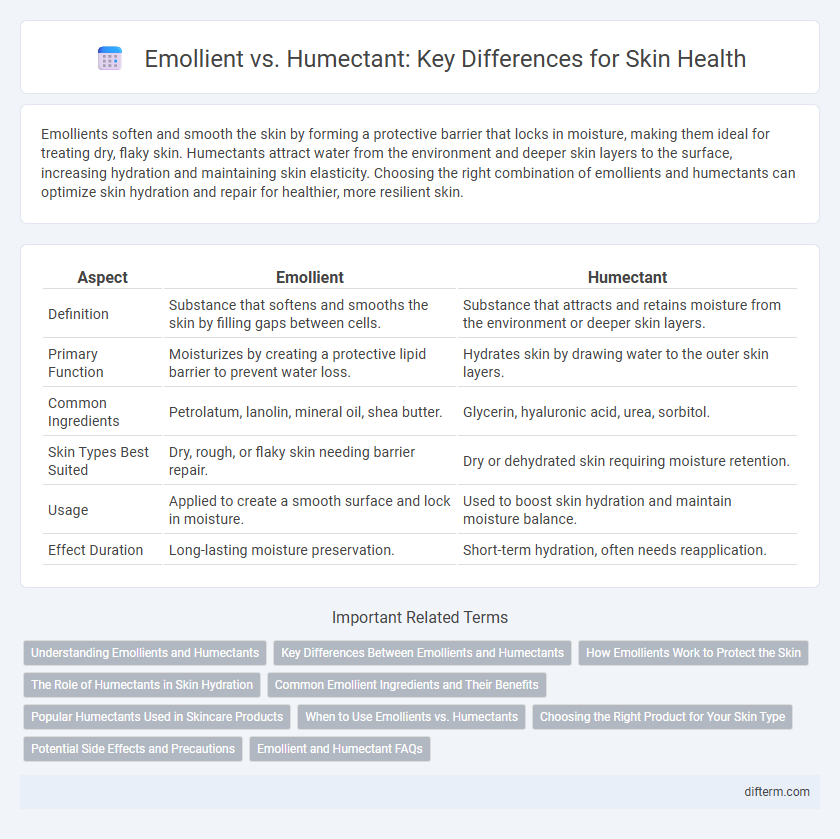Emollients soften and smooth the skin by forming a protective barrier that locks in moisture, making them ideal for treating dry, flaky skin. Humectants attract water from the environment and deeper skin layers to the surface, increasing hydration and maintaining skin elasticity. Choosing the right combination of emollients and humectants can optimize skin hydration and repair for healthier, more resilient skin.
Table of Comparison
| Aspect | Emollient | Humectant |
|---|---|---|
| Definition | Substance that softens and smooths the skin by filling gaps between cells. | Substance that attracts and retains moisture from the environment or deeper skin layers. |
| Primary Function | Moisturizes by creating a protective lipid barrier to prevent water loss. | Hydrates skin by drawing water to the outer skin layers. |
| Common Ingredients | Petrolatum, lanolin, mineral oil, shea butter. | Glycerin, hyaluronic acid, urea, sorbitol. |
| Skin Types Best Suited | Dry, rough, or flaky skin needing barrier repair. | Dry or dehydrated skin requiring moisture retention. |
| Usage | Applied to create a smooth surface and lock in moisture. | Used to boost skin hydration and maintain moisture balance. |
| Effect Duration | Long-lasting moisture preservation. | Short-term hydration, often needs reapplication. |
Understanding Emollients and Humectants
Emollients are lipid-rich substances that create a protective barrier on the skin, sealing in moisture and softening the outer layer by filling gaps between skin cells. Humectants attract and retain water from the environment and deeper skin layers, maintaining hydration by increasing water content in the stratum corneum. Combining emollients and humectants in skincare products optimizes skin moisture balance, improving hydration, texture, and barrier function for dry or sensitive skin conditions.
Key Differences Between Emollients and Humectants
Emollients primarily function by creating a protective barrier on the skin's surface to lock in moisture and improve texture, often including ingredients like oils, butters, and lipids. Humectants attract water from the environment and deeper skin layers to the outer skin, with common agents such as glycerin, hyaluronic acid, and urea. Understanding these key differences helps determine their appropriate use in skincare formulations for optimal hydration and barrier repair.
How Emollients Work to Protect the Skin
Emollients work by filling the gaps between skin cells with lipids, creating a protective barrier that locks in moisture and prevents water loss. This barrier not only soothes and softens dry, rough skin but also enhances the skin's natural repair process. Unlike humectants that attract water, emollients primarily focus on reinforcing the skin's lipid layer to maintain hydration and protect against environmental irritants.
The Role of Humectants in Skin Hydration
Humectants such as glycerin, hyaluronic acid, and urea attract and bind water molecules to the skin, effectively increasing moisture retention within the epidermis. These substances penetrate the stratum corneum, enhancing hydration by drawing water from deeper skin layers and the environment, which improves skin elasticity and barrier function. Humectants play a crucial role in preventing dryness and managing conditions like eczema by maintaining optimal skin hydration levels.
Common Emollient Ingredients and Their Benefits
Common emollient ingredients include petrolatum, shea butter, and lanolin, known for their ability to soften and smooth the skin by forming a protective barrier that prevents moisture loss. These ingredients enhance skin hydration by filling in gaps between skin cells, promoting a supple and flexible texture. Incorporating emollients into skincare routines helps repair dry, cracked skin and supports overall skin barrier health.
Popular Humectants Used in Skincare Products
Popular humectants used in skincare products include glycerin, hyaluronic acid, and sorbitol, all known for their ability to attract and retain moisture within the skin. These ingredients enhance hydration by drawing water from the environment and deeper skin layers, improving skin elasticity and smoothness. Unlike emollients, which mainly create a protective barrier to prevent moisture loss, humectants actively increase the skin's water content for lasting moisture balance.
When to Use Emollients vs. Humectants
Emollients are best used for restoring the skin's barrier and smoothing rough, dry patches, particularly in conditions like eczema or psoriasis where skin repair is critical. Humectants work efficiently to attract and retain moisture in the skin, making them ideal for dehydrated skin or environments with low humidity. Combining both can provide optimal hydration, with humectants drawing moisture in and emollients sealing it to maintain skin softness and elasticity.
Choosing the Right Product for Your Skin Type
Emollients are best suited for dry or rough skin as they create a protective barrier that locks in moisture and softens the skin, while humectants attract water from the environment or deeper skin layers, making them ideal for dehydrated or combination skin types. Ingredients like shea butter and petrolatum are common emollients that soothe and repair the skin's surface, whereas glycerin and hyaluronic acid are effective humectants that enhance hydration by drawing moisture into the skin. Selecting the right product depends on assessing your skin's hydration needs, with emollients providing long-lasting moisture retention and humectants boosting immediate hydration.
Potential Side Effects and Precautions
Emollients, used to soften and smooth the skin, can sometimes cause allergic reactions or worsen acne due to their occlusive nature, while humectants, which attract moisture, may lead to irritation or increased sensitivity if used excessively or on damaged skin. It is crucial to choose products based on skin type and to patch test before regular application to minimize adverse effects. Consulting a dermatologist is recommended when using emollients or humectants for sensitive skin or underlying skin conditions.
Emollient and Humectant FAQs
Emollients are moisturizing agents that create a protective barrier on the skin, sealing in moisture and improving skin softness, while humectants attract water from deeper skin layers or the environment to hydrate the skin. Common emollients include oils, shea butter, and petrolatum, whereas humectants like glycerin, hyaluronic acid, and urea help maintain skin moisture balance. Frequently asked questions about emollients and humectants focus on their differences, usage in skincare routines, and ideal skin types for each ingredient.
Emollient vs Humectant Infographic

 difterm.com
difterm.com